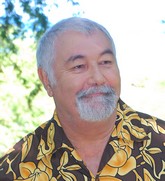
Updated on 04/20/2016 E.J.
My late friend, Pierre MOULIN (1948-2016), founder of the Freedom and Liberty Trail in Bruyères (Vosges, France), passed away last month in Honolulu, Hawai’i. May he not be forgotten for his amazing life work in honoring his heroes – the bravest Japanese American citizens of the legendary 442nd Regimental Combat Team of Nisei Soldiers of Hawai’i and the Mainland – who liberated his hometown of Bruyères (Vosges), France in October 1944. Elisabeth Jenssen
For immediate release:
Dear MDFDE members, dear Internet friends,
I am delighted to inform you our friend Pierre MOULIN has been nominated Senior Team Leader MDFDE/Hawaii/Oahu/Honolulu. Born and raised in Bruyères, Vosges, France, Pierre, proud father of two sons, Sebastien and Martin, is an author-historian and volunteer at the U.S. Army Museum of Hawaii at Fort DeRussy, Honolulu, Hawaii.
Since his childhood, Pierre has been fascinated by the history of WWII and the exploits of the 442nd Regimental Combat Team of Nisei, the second-generation of Japanese immigrants whose sons were born and educated in the United States. The 442nd RCT counted among its finest soldiers the late Senators Daniel Inouye and Spark Matsunaga of Hawaii.
One can understand Pierre’s passion knowing that during the war, in Bruyères, Resistance was active. And Pierre’s own father, Max Henri Moulin, a bookseller by trade, was an intelligence officer working for the OSS. His information network received praise from the division for the quality and volume of information provided. In order to help their advance, ten guides helped American forces find their way through the forest.
Named official Ambassador of Bruyères-Hawaii Friendship in 1969, Pierre has since dedicated himself in multiplying cultural exchanges between Bruyères, France, and its sister-city Honolulu, Hawaii (Oct. 15, 1961), President Barack Obama’s birthplace.
He has written several books in both French and English and done museum exhibits in order to teach the new generation all about the all-Nisei U.S. Army regiment from Hawaii and California. These extraordinary warriors engaged in the Battle of Bruyères and Biffontaine, who managed to free his hometown on October 15, 1944; and two weeks later, October 30, successfully rescued behind enemy lines the legendary “Lost Batallion” (1st Battalion of the 141st “Alamo” Regiment, 36th Texas-Division) where more than 800 troops were lost.
In honor of his late grandfather, Charles Etienne, former Deputy mayor of Bruyères, and his father Max, Pierre created in July 1989 the Peace and Freedom Trail (CPL) on the path of the 100/442nd RCT thus leaving in Bruyères a permanent mark of the Niseis, the “US Samurais” as Pierre calls our heroes, a historic place imprinted forever in our collective memory.
This year will mark the 25th Anniversary of the Peace and Freedom Trail and the 70th Anniversary of the liberation of Bruyères. As in previous years, families and friends of Nisei Veterans from Hawaii and California and other parts of the United States and the world will come to Bruyères to take part in the official celebrations.
Yours faithfully,
Elisabeth Jenssen
Bruyères and the Holocaust
http://www.youtube.com/watch?v=jhBf3R3MGPE
http://www.hiarmymuseumsoc.org/video-intro.html
http://www.hiarmymuseumsoc.org/
The Battle of Bruyères (Vosges) and the Rescue of the Lost Battalion by the 442nd RCT in October 1944
http://www.asian-nation.org/442.shtml
http://www.the442.org/battlehistory/vosges.html
The 100th/442nd Regimental Combat Team (RCT), the most decorated military unit in the U.S. Army
http://www.442film.com/ http://www.youtube.com/watch?v=IpjaQ8lJqmY
http://www.nisei100442mishistory.com/
https://www.njahs.org/research/references/442_research.php
History in Lorraine : The “Lost Battalion.”
Video: http://www.touteslesvosges.com/histoire.html
http://www.bruyeres-vosges.fr/
Celebrating the exploits of the 100th/442nd RCT in France and the United States of America
– October 18, 1947: Unveiling of the American Monument
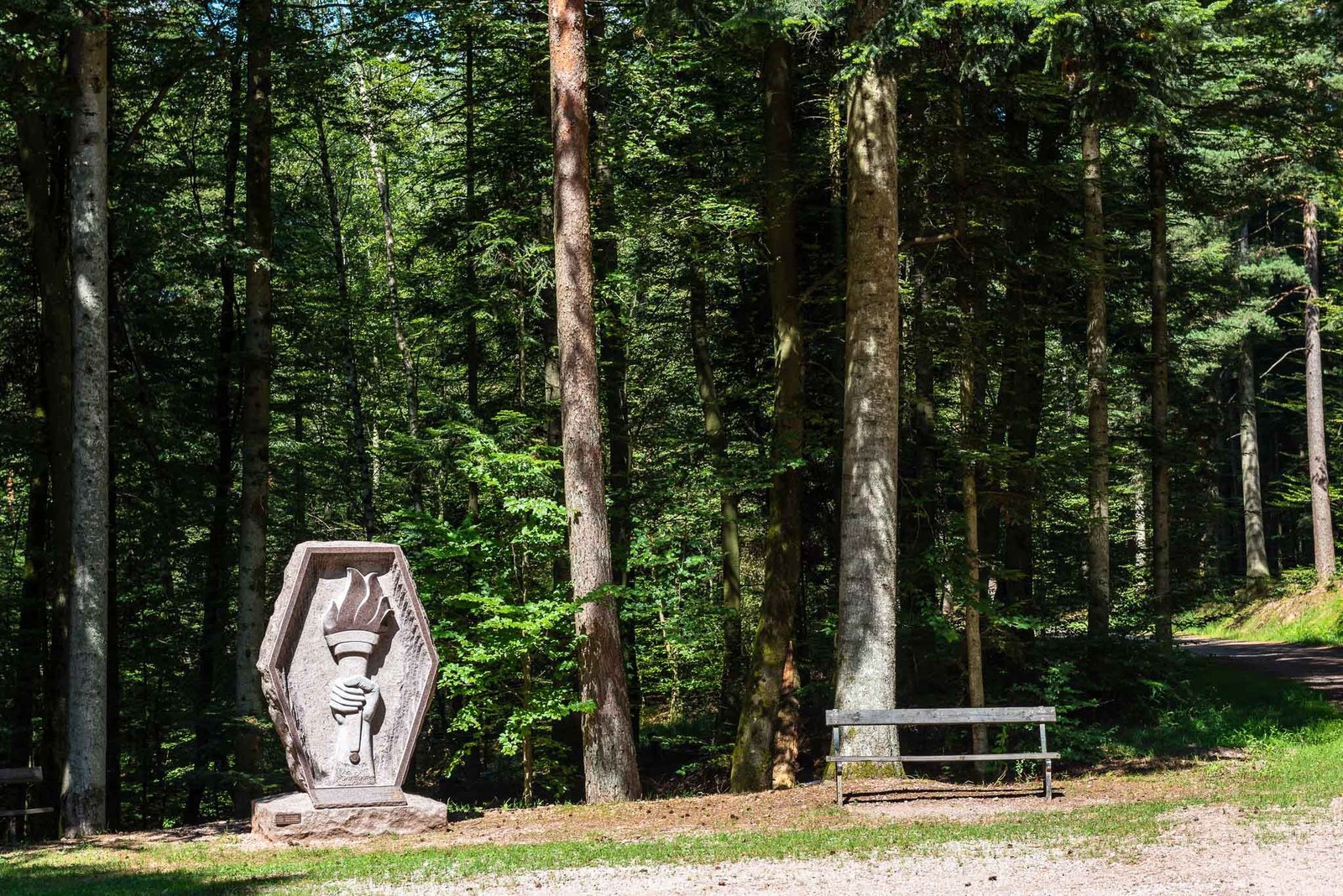
The American Monument of the 442th RCT
On October 18, 1947 Bruyères celebrates the anniversay of its dramatic liberation. For this occasion, Louis Gillon, Mayor of Bruyères and former Resistant, receives on behalf of the Cité de l’Avison, a bronze plaque presented to him by veteran Wilson Makabe of the Japanese American Citizens League. This plaque describes the Lost Battalion’s rescue by the men of the 442th RCT during the Battle of Bruyères. Instead of affixing the plaque to the walls of City Hall as it was then customary, Mayor Louis Gillon and his Deputy, Charles Etienne (Pierre Moulin’s grandfather) decide to build a real Memorial in honor of these gentlemen soldiers who saved their town from total destruction. Gillon and Etienne decide that the monument will be erected in the middle of nature thus offering a peaceful and serene setting in perfect harmony with Japanese-American philosophy.
On Thursday, October 30, 1947, the only European monument dedicated to one single military unit, is unveiled in the presence of French and American officials. Robert Valantin read a message from Colonel Virgil Miller commanding the 442th RCT.
– July 9, 1989: Unveiling of the Peace and Liberty Fountain at Place du Commandant Flesch, in the center of Bruyères-sur-Vosges, France, offered by Pierre Moulin and Serge Carlesso. This water feature by Jean Bianchetti is adorned with seven columns of granite bearing the words Peace and Liberty in gold symbolizing the fighting spirit of the Seventh United States Army, complimented by a bronze torch sculpture by J-B Thouvenot. The artist was inspired by Sgt Miyamoto’s insigna depicting the French torch of Lady Liberty carried by two arms, one American, one French, from which a dove emerges.
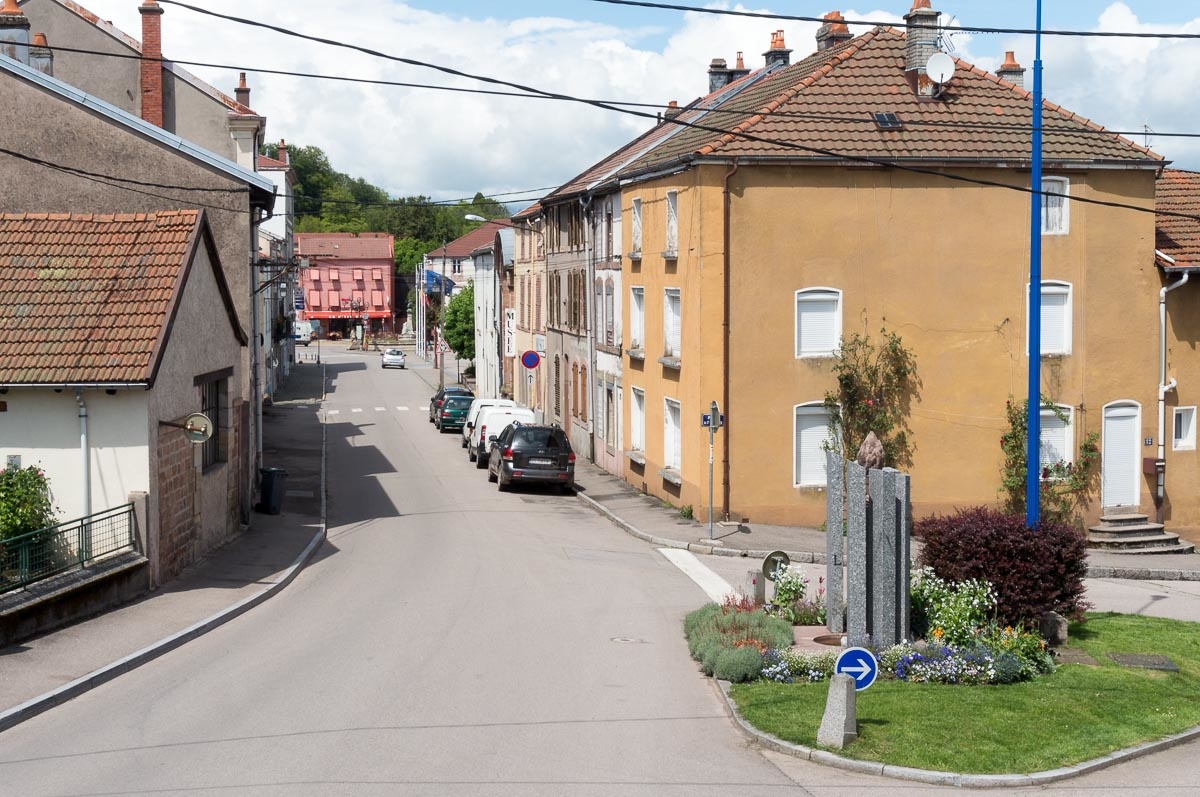
– July 9, 1989: Unveiling of the Peace and Liberty Fountain at Place du Commandant Flesch, in the center of Bruyères-sur-Vosges, France, offered by Pierre Moulin and Serge Carlesso. This water feature by Jean Bianchetti is adorned with seven columns of granite bearing the words Peace and Liberty in gold symbolizing the fighting spirit of the Seventh United States Army, complimented by a bronze torch sculpture by J-B Thouvenot. The artist was inspired by Sgt Miyamoto’s insigna depicting the French torch of Lady Liberty carried by two arms, one American, one French, from which a dove emerges.
Go For Broke Association
History of the Patch

The shoulder sleeve insignia design was created by Technical Sergeant Mitch Miyamoto of the 3rd Battalion, 442nd Infantry Regiment. It depicts the torch of Liberty on a blue background with red and white borders. The design was approved for wear on December 16, 1943.
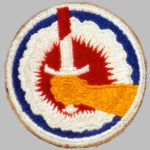
Original Design of the patch
Torch of Liberty Story
Mitch Miyamoto
The first design of the 442nd Regimental Combat Team’s shoulder sleeve insignia was round with a red and white bomb burst on a blue background (signifying the National Colors), with a yellow arm (representing the Japanese Americans) holding a bloody sword. Although the design was approved on July 31, 1943, it was met with criticism from the 442, who objected to its design, especially the representation of the yellow arm.
In communication with Colonel Charles W. Pence (Commander of the 442nd RCT) and Joseph R. Farrington (Hawaii Territorial Congressional Delegate), the Office of the Secretary of War became aware of the dissatisfaction with the original design and stopped production of the patch.
The second shoulder sleeve insignia design was created by Technical Sergeant Mitch Miyamoto of the 3rd Battalion, 442nd Infantry Regiment. It depicts the torch of Liberty on a blue background with red and white borders. The design was approved for wear on December 16, 1943. http://gfbassn.org/history-of-the-patch.html
– July 8-9, 1994: Dedication of the Freedom and Liberty Trail created by Pierre Moulin tracing the liberation route of the 2nd, 3rd, and 100th Battalion forming the 442nd RCT by using 89 commemorative plaques placed throughout the region.
The Freedom and Liberty Trail
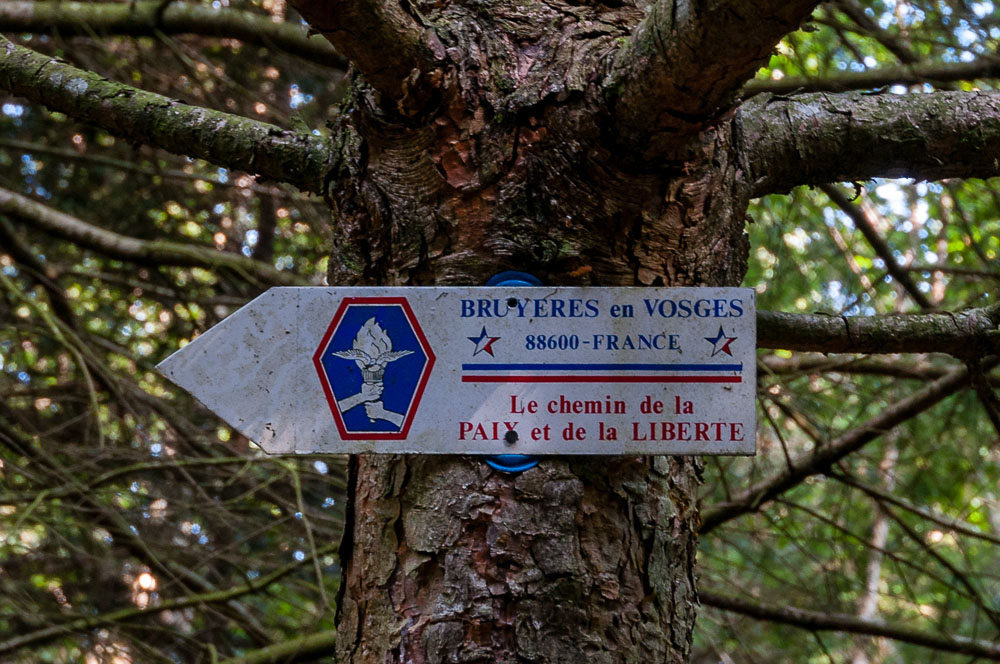
Bruyères-Vosges, Sigle du Chemin de la Paix et de la Liberté Bruyères-Vosges. © Pierre Poix bruyeres-vosges.fr
The Freedom and Liberty Trail was founded by my friend Pierre MOULIN. It retraces the route used by the 2nd, 3rd, and 100th Battalion forming the 442nd RCT which freed BRUYÈRES from the Nazis in October 1944. Pierre’s father was Max Henri MOULIN, a member of the Office of Strategic Service (OSS) and one of the leaders of the heroic French Resistance in Bruyeres-in-Vosges (France) in WWII. E.J.
The Freedom and Liberty Trail in Bruyères-sur-Vosges. © Pierre Poix bruyeres-vosges.fr Le Chemin de la Paix et de la Liberté a été fondé par Pierre MOULIN sur la trace du parcours du 100/442 ème Régiment de Combat de l’Armée des États-Unis qui a libéré BRUYÈRES en Octobre 1944.http://www.bruyeres-vosges.fr/article-bruyeres-vosges-le-chemin-de-la-paix-et-de-la-liberte-fonde-par-pierre-moulin-115822068.html
French Links:
http://www.ville-bruyeres.fr/fr/la-liberation-de-bruyeres-1.html
http://www.tourisme-bruyeres.com/le-chemin-de-la-paix-et-de-la-liberte https://www.facebook.com/pages/Bruy{4d24daa5a359aa22e51c71c531e935ff229d31c7c5eb0da4885e362fa152ead6}C3{4d24daa5a359aa22e51c71c531e935ff229d31c7c5eb0da4885e362fa152ead6}A8res-en-Vosges-Chemin-de-la-Paix-et-de-la-Libert{4d24daa5a359aa22e51c71c531e935ff229d31c7c5eb0da4885e362fa152ead6}C3{4d24daa5a359aa22e51c71c531e935ff229d31c7c5eb0da4885e362fa152ead6}A9/116928911799160 http://bruyereschemindelapaix.over-blog.com/

******************************************
The 50th Anniversary of Bruyères’ Liberation
– October 16, 1994: Unveiling of the Friendship Knot

Professor Shinkichi Tajiri (1923-2009)
Shikichi Tajiri creates the limestone sculpture “Father and Son” at his studio on Drexel Street. 1946Tajiri is a well known name to many Japanese Americans in Chicago. Shinkichi is the fifth of seven children born to Ryukichi and Fuyo Tajiri. His oldest brother, Larry, was editor of the Pacific Citizen, the bi-monthly newspaper of the Japanese American Citizens League, during World War II. The second son died at age three in an influenza epidemic. The third son, Vincent, was part of the 442nd RCT and is best known as picture editor and director of photography of Playboy Magazine from 1954 to 1971. He edited “Through Innocent Eyes,” a collection of works by Nisei. His sister, Yoshiko, edited the Tokyo area edition of the Stars and Stripes as well as other magazines. Younger than Shinkichi are twins. James was a career military officer with the rank of lieutenant colonel. He commanded Airborne Intelligence units in Vietnam and Okinawa.
Growing up in San Diego, Shinkichi always liked art. He showed his works to Ruth Hall, who introduced him to Donal Hord. Because Shinkichi could not afford sculpturing lessons, he was grateful to Hord for permitting him to care for his garden in exchange for lessons. This was the beginning of sculpturing for him.
The lessons ended in 1942 when his family was evacuated to Poston Concentration Camp in Arizona. In Camp 3, Shinkichi did a series of Conte crayon drawings of camp life with art materials sent by Hord. From there, he volunteered for the 442nd RCT and joined his brother Vincent at Camp Shelby in Mississippi where they trained together.
Shinkichi was a machine gunner in Company M, Third Battalion of the 442nd RCT, which was the heavy weapons unit. He was hit on his left thigh on July 9, 1944 during an attack on Castellina, Italy. Flown to Rome, more than 50 pieces of stone were removed and he was in a cast for six months. He was transferred to Marseilles, France, and given limited duty.
In 1945, he requested and was granted Special Services as an artist to sketch displaced persons from the German concentration camps. This reminded him of his days at Poston. Many of Shinkichi’s art reflect the horrors of war such as “Wounded Knee” (1953), “Scorched Eart (1955), and “Nagasaki” (1957).
The Gaka Art Club in 1947. The club met in Shinjiki Tajiri’s basement studio
At the end of military service, Shinkichi came to Chicago to be with his mother and family. He worked at Matsumoto’s Art Shop and on the GI Bill attended the School of the Art Institute of Chicago, which he considers to be the best of the four art schools he attended. He studied art history, painting, and design.
From there, he went to Paris to escape racism suffered in the U.S. and to study art with cubist sculptor, Ossip Zadkins, whom he left to have freedom to develop in his own art style. (…)
The Friendship Knot
« The Friendship Knot », created by Professor Shinkichi TAJIRI, is a gift from the 100th BN Club, the 442nd Club Hawaii and the 100th/442nd Veterans Association USA to the People of Bruyères. It was dedicated on October 16, 1994 for the 50th Anniversary of the Battle of Bruyères. This work of art was inspired by the love and gratitude Professor Tajiri personally felt from the people of Bruyères led by Serge Carlesso when he visited the town in October 1993.
His friendship knots are well known and can be found all over the world. One is displayed outside the Japanese American National Museum in Los Angeles. “Granny Knot” is at the Rockefeller Foundation in New York City and another in Bruyeres in France, commemorating 50 years of liberation by the 442nd Regimental Combat Team (RCT).
In 1953, the artist’s work came to the attention of COBRA, an art group of revolutionary experimental artists and protestors from Copenhagen, Brussels, and Amsterdam. The Dutch group was drawn to Tajiri’s works and labeled him an abstract surrealist. Later in 1964, the artist and his family moved to Minnesota to the Art Institute of Minneapolis where he had a one-year visiting professorship with Arnold Herstand. During this time, Tajiri completed 25 bronze sculptures for an exhibit and created a monumental sculpture for St. Paul, Minnesota.
http://www.discovernikkei.org/en/journal/2006/9/13/voices-of-chicago/
*********************************
Go For Broke Monument

Close-up view:

– June 5, 1999: Unveiling of the Go For Broke Monument in Los Angeles, California
From Honolulu, Hawaii, to Bruyères, France, to Little Tokyo in Los Angeles, California… On June 5, 1999 the dreams of a determined group of World War II veterans came to life with the unveiling of the Go For Broke Monument in the Little Tokyo district of Los Angeles, California. E.J.
http://www.goforbroke.org/index.php
Information
Information from the 100th/442nd/MIS World War II Memorial Foundation press release: The first Monument of its kind in the Mainland U.S. to honor the World War II Heroics of Japanese American soldiers who fought bravely while their families were held in U. S. internment camps.
It commemorates the 100th Infantry Battalion, 442nd Regimental Combat Team, Military Intelligence Service, 522nd Field Artillery Battalion, 232nd Combat Engineering Company and the 1399th Engineering Construction Battalion. The monument was built by the non-profit 100th/442nd/MIS World War II Memorial Foundation and given to the City of Los Angeles. The Memorial Foundation is providing upkeep for the Monument. The idea for a monument was conceived by a group of veterans and initiated in 1990 by the 100th/442nd/MIS World War II Memorial Foundation with an international design competition.
The Go For Broke Monument design was chosen from 138 entries in the blind and juried competition and the winning design by Roger Yangita was publicly presented January 14, 1991. The design comprises a 40 foot granite circle of bold, black granite, rising to a peak of 9 feet and slping to grade level on the front.
A curving vertical perimeter wall is engraved with names of 16,000 Nisei soldiers and their officers who served overseas during World War II, including 37 Japanese American women.
An inscribed star designates those killed in action.
A semicircle of 60 colorful organizational patches from the various units with which the 100th, 442nd, MIS and other Nisei soldiers were attached and/or assigned during World War II runs along the upper edge of the wall above the names. The round, flat face of the Monument tells the story of the 100th, 442nd, MIS, 552nd, 232 and 1399th with five large medallions and moving inscription.
A granite replica of the 442nd shoulder patch topped with the brilliant image of a torch and an upright arms borrowed from the Statue of Liberty are set in front of the inscription.
The granite shoulder patch holds a symbolic flame as a lasting reminder of those who died in battle, and an American Flag. The approach to the monument is a checkerboard of grass and granite, with a ring of grass circling all the way around.
Two clusters of stately donor pillars acknowledge contributors and supports. A convenient kiosk houses a computerized name locator or “monument map.”
More than a dozen cherry plum and Japanese maple trees stand near the wall of names and the surrounding plaza is paved with stone.
Background: During World War II, American citizens of Japanese ancestry were classified by the U.S. Government as “enemy aliens” and imprisoned in internment campus without due process of law.
Although deprived of their constitutional rights, thousands of young men and women volunteered out of these campus to serve in segregated units of the 100th/442nd Regimental Combat Team fighting in Europe, and with the Military Intelligence Service (MIS) in the Pacific.
Through remarkably distinguished service, the 100th/442nd RTC and MIS helped restore freedom and civil rights, not only for future generations of Japanese Americans but also for all Americans.
Through sacrifice and heroics, they demonstrated that civil liberties are inalienable and should never be denied to anyone because of race or ancestry. In 1989, Japanese American World War II veterans established the Foundation to build the Go for Broke Monument, as well as an educational program using the stories of these veterans to illustrate constitutional issues and civil rights.
The Monument, located in Downtown Los Angeles adjacent to the Geffen Contemporary at MOCA and north of the Japanese American National Museum, was unveiled in June 1999 and presented as a gift to the City.


The 60th Anniversary of Bruyères’ Liberation
In the fall of 2004, to mark the 60th anniversary, some 442nd RCT veterans including Shinkichi Tajiri returned to Bruyeres in remembrance.
NISEIS INVITED TO FRENCH 60TH ANNIVERSARY OF LIBERATION. SCHOOL CHILDREN ENTHUSIASM ENSURES FUTURE CELEBRATIONS
Bruyeres, France. Each year for the past 60 years, on a weekend in October, the citizens of Bruyeres and nearby Biffontaine and Belmont in the Vosges mountains of eastern France, honor the all Japanese American 442nd Regimental Combat Team (RCT) including the 100th Battalion for liberating them from Nazi forces during WW II. This year, however, was special. On October 24, 2004, the 60th anniversary, Lawson Sakai, a 442nd veteran, escorted a large delegation of 442nd veterans, families and friends to participate in the liberation festivities. As with the 50th anniversary in 1994, also led by Mr. Sakai, school children waving French and American flags, township officials, and the populace poured out their welcome over two days with incredible hospitality, ceremonies and banquets at various locations. Significantly, the organizers represented the post WW II generation.
The towns of Bruyeres, Belmont, Biffontaine, and Fremifontaine were liberated in October 1944 by the 442nd RCT, comprised of Japanese Americans from Hawaii and Mainland United States, many from the 10 internment camps where 120,000 Japanese Americans were incarcerated.
As in past years, all of the 53 persons in the delegation had similar objectives in going: to pay tribute to relatives and friends who were engaged for three weeks in the most bitter, non-stop fighting in which the 442nd RCT sustained more than 800 casualties. The seven 442nd veterans on this trip were Ted Fujimoto, Santa Ana, CA, Co. E; Roy Fujiwara, Seattle, WA, Co. L; Jimmie Kanaya, Gig Harbor, WA, 3rd Battalion Medical Specialist; Ted Oye, Seattle, WA, 3rd Battalion Headquarters; Lawson Sakai, Gilroy, CA, Co. E; Mike Tsuji, Los Angeles, CA, Co. H; and Willie Tanamachi, Houston, TX, who was in 442nd training at the time. Some stood on the same spot they stood in October 1944 each with his own story to tell. Mike Tsuji pointed to the house where he spent one night.
The festivities started on the first day, October 23, when 200 people of Fremifontaine, including resistance fighters with unit flags, honored the Japanese Americans with a band and speeches. The band played the American and French national anthems and Mayor Etienne Pourcher talked of how they were liberated by the Japanese Americans. Following that, about 300 residents of the town of Belmont invited the Japanese Americans for lunch and more celebratory speeches and entertainment.
According to Greg Kimura of Palo Alto, California, “what happened next was overwhelming. A group of men dressed in WW II army fatigues and boots stepped up to the stage and sang God Bless America. Never had I witnessed this depth of honor and respect accorded to any group of people … here were these people singing God Bless America and honoring not just these Americans, these veterans, their friends and families, but America and all Americans. I’ve never been a particularly patriotic person, but at that moment I was truly proud to be an American”.
From Belmont the visitors were taken to Biffontaine forests and toured the location, with all the grim evidence such as foxholes and shrapnel imbedded in trees, where 442nd Regimental Combat Team rescued the trapped 1st Battalion, 141st Regiment, 36th (Texas) Division (referred to by the press at the time as the “Lost Battalion”) in what the U.S. Army historical records recognized as one of the 10 most fiercely fought battles in its entire history.
Jimmie Kanaya of Gig Harbor, Washington, who first saw the battle ground as a medic tending to the wounded during the battle, said “as I might not be around 10 years from now, I felt that it would be appropriate for me to pay my respects to those people of France, including the courageous French resistance movement whose contributions made a significant difference. The children in each community played a big part at the monuments as well as at the city squares by assisting in the laying of the wreaths. I thought this gesture on the part of the French people was one of the finest tributes they could pay those veterans who participated in their liberation, and to continue this tradition for years to come.”
The highlights of the second day, October 24, began with mass at Bruyere’s main church, where a memorial service was held in the Bruyeres town square. From there the Japanese Americans were taken to Helladraye forest riding in WWII jeeps and command cars, where a major battle for the liberation of Bruyeres occurred. The German Army was ordered to hold this position at all costs as this was the main rail line supporting the German troops on the western front. After two weeks of heavy fighting the enemy was defeated.
On returning to Bruyeres, where a monument in honor the 442nd RCT was erected, over 400 town people took part in the celebration. Monuments have been similarly erected for the 45th and 36th Infantry Divisions. There were many school children waving French and American flags, French and American dignitaries, military and youth bands and a church choir which sang the Star Spangled Banner. All took part. Remembering a request made previously by the French, Sakai placed a WW II American soldier’s helmet donated by the American Military Museum of Los Angeles on the top of the monument much to the pleasure of Bruyeres people,. The front of the helmet bears the 442nd insignia painted on by retired Air Force Colonel Brian Shiroyama. The visitors were pleased to see that Bruyeres has named one of their streets, “Rue de 442nd Regimental Combat Team.”
The group then went to the Bruyeres City Hall for a reception and program by Bruyeres Mayor Alain Blangy, also attended by Mayor of Biffontaine Denis Henry, President of the Association for Peace and Freedom Martial Hilaire, U.S. Consul General Christopher Davis, and Superintendent of Epinal American Cemetery Tom Cavaness. Blangy spoke of the liberation of Bruyeres on October 18, 1944 by a “group of American soldiers that looked more Japanese than American.” Children are taught in school they must remember and honor their liberators. Mayor Henry spoke of the great battles that raged through the hills of Biffontaine culminating in the rescue of the Lost Battalion.
Following the lunch the Group went to the Epinal American Cemetery in Dinoze-Quequement for a memorial service at the five gravesites of the 442nd soldiers interred there. At the gravesite of Tomosu Hirahara, his nephew Ed Hirahara, a Sansei from Federal Way, Washington, was deeply moved by the experience. He said, “At the U.S. Military Cemetery in Epinal, France honors those soldiers missing in action as well as those for whom their families chose to leave their remains where they died. It is a sad but very impressive sight to see the many rows and rows of white marble crosses, each marking the place where a soldier is buried. The small ceremony that was held to honor Tomosu Hirahara spontaneously developed into a larger and emotionally beautiful ceremony for the group as many came up one by one to light incense and to reflect in a moment of silence. I cannot speak for others but for me, it was a moment to honor all those who fought and died in this place.”
Sandra Tanamachi, a Texas school teacher whose uncle was killed in the battle to rescue the Texas “Lost Battalion,” expressed the sentiments of many of the visitors when she said: “I decided to make this trip, as I wanted to be in one of the exact locations where my heroes, the Nisei veterans, fought and sacrificed, so that we, the future generations of Japanese Americans, could live in a more accepting, understanding America in the aftermath of WWII. Once we reached the Vosges Mountain area of France and visited the liberated towns of Fremifontaine, Biffontaine and Bruyeres, the French people welcomed us with open-arms, and you could feel the sincere warmth and love that they held for our veterans. When our bus approached their towns, we were greeted like ‘super stars’ as there was always a large group of citizens waiting to greet us, all waving American and French flags. The dignitaries of the towns were in attendance and gave speeches of welcome and thanks to the veterans. Each time this happened, I thought of my uncle, Saburo Tanamachi, and all of our Japanese American soldiers who sacrificed so much for each of us. It was especially wonderful to see the groups of children, as they will pass these stories on to the next generations. Visiting the Vosges was my way of saying, ‘Domo arigato gozaimasu’ to my heroes.”
Mrs. Margaret Miyasaki, wife of the late Dr. Robert M. Miyasaki, a 442nd medic, and her two daughters, Nola and Gaye, went on this tour. After her return home to Honolulu, Mrs. Miyasaki said “The tour to Bruyeres was a wonderful experience! I learned so much about the war that my husband served to save lives. It was heartwarming to be welcomed by the people and children of Bruyeres, and to see how much they still appreciate the veterans after all of these years. It was really a memorable trip for me.” Nola and Gaye shared the same view in a joint statement: “Visiting the battlefields of Bruyeres, Epinal and Biffontaine offered us a wonderful glimpse of history that the 442nd was responsible for. We have a much greater understanding of the magnitude of courage, humility, pride and “go for broke” spirit exhibited by the Japanese American soldiers in spite of the prejudice they constantly faced. We feel a great sense of pride in our Dad and for all of the Japanese Americans who fought in WWII.”
Other Japanese Americans living in Europe visited Bruyeres to join the Sakai party. One was Shinkichi Tajiri, sculptor of the cast iron “Knot of Friendship”, located only 100 yards from the 442nd monument in Bruyeres. Tajiri is an internationally recognized sculptor who resides in Baarlo, Netherlands, a native Californian, Poston Internment camp internee, 442nd (Co. M) veteran and brother of the late Larry Tajiri, Editor of Pacific Citizen. Tajiri presented the Knot to Bruyeres in 1994 during its 50th Liberation celebration. He conceived of the idea of the Knot in the 1960’s and designed it with the view that each person could interpret its significance. To Tajiri, it symbolizes the bond of friendship between Bruyeres and 442nd. Tajiri brought his family to Bruyeres for this 60th celebration and to meet his long time friend, Isami Tsuji, squad leader of Co. H, 442nd RCT , who was wounded two days after the liberation of Bruyeres in the Biffontaine operation.
Another visitor was Everett Wakai from the U.S. Embasy in Paris, who visited with his father, Ted Wakai, Military Intelligence Service veteran and resident of Oxnard, California.
Mr. Sakai observed that the lush vegetation and serene atmosphere of the Vosges today belie the fierce battle for freedom that occurred 60 years ago with artillery rounds toppling huge trees, machine gun fire ripping through the air and vegetation incessantly, the clash of bayonets in hand to hand combat, the sounds of the wounded and dying on both sides. Sakai, who was wounded himself, remembers an elderly French woman taking a mortally wounded Nisei into her home, putting him on her bed, where he peacefully passed away. Sakai’s group reciprocated the generosity of the French with gifts and speeches. This outpouring of hospitality by the Bruyeres, Biffontaine and Belmont townfolks is accorded to every Japanese American who come during the year alone or in any numbers. An emotional experience for all, one of the younger members of the group moved by the days’ events, attempted to register for Sakai’s 70th anniversary tour in 2014 as the time for departure drew near.
Link: http://javadc.org/Invitation%20to%2060th%20Anniversary%20French%20celebration.htm
– March 18, 2009
Shinkichi Tajiri passed away…
Known around the world for his artwork, Shinkichi Tajiri passed away from a long illness on Sunday March 15, 2009 in Baalo, the Netherlands. Posthumously this wonderful artist and great friend of Bruyères received the Congressional gold medal from President Obama for serving in the 442nd RCT (US Army) in the Second World War…
American sculptor, Shinkichi Tajiri was also a painter, photographer and movie director. In 1955 he won a Golden Palm at Cannes, for his first short film, The Vipers, because of his experimental use of the language of film. From 1956 he lived in the Netherlands, since 1962 in Baarlo. He worked as a sculptor and painter. He exhibited at the famous Kassel documenta II, 1959; III, 1964 and IV, 1968. From 1969 Tajiri Shinkichi taught at the Hochschule für Bildende Künste at Berlin. 1969 and 1970 Shinkichi took pictures of every part of the Berlin Wall.
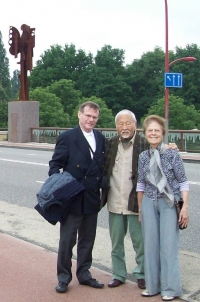 Shinkichi Tajiri, his wife Suzanne and Bruyeran Gérard Henry. The sculptures
seen on this bridge in Holland are from the artist.
Shinkichi Tajiri, his wife Suzanne and Bruyeran Gérard Henry. The sculptures
seen on this bridge in Holland are from the artist.
In 1970 he went to Denmark and directed the award-winning documentary Bodil Joensen – en sommerdag juli 1970 about Bodil Joensen. In 1975 and 1976 he recreated the Daguerreotype: surreal portraits, nudes and daguerreotypes of the Wall. He had two daughters, Giotta et Ryu. He is survived by his sister Yoshiko and his brother James.
http://lagirafequirit.blogspirit.com/tag/shinkichi+tajiri
http://en.wikipedia.org/wiki/Shinkichi_Tajiri
http://shinkichi-tajiri.com/ http://rdpauw.blogspot.fr/2009/03/berlin-wall-1969-1970-photographs-by.html
*******************************
A Legacy for My Sons
I was honored to have lunch with Ted Tsukiyama, retired lawyer and MIS and 442nd historian, and James Tanabe, MIS historian. They were both WWII veterans in their late 80s that I had asked to proof my new books. Ted Tsukiyama’s question took me a little by surprise: “Why did you spend so much of your life writing and researching about us (Japanese Americans)?” I believe there are many reasons.
The first thing, of course, is I probably owe my life to the Japanese Americans. They came just in time to liberate my home town of Bruyeres before my father would have been caught for his spying activities as a member of the Office of Strategic Service and one of the leaders of the French Resistance in Bruyeres-in-Vosges (France).
Second, I grew up fundamentally anti-racist and the story of the Nisei fit into my goals. After all there was such discrimination after the bombing of Pearl Harbor in Hawaii. Third, I was already the historian of Bruyeres at the age of 16 years old. The battle of Bruyeres and the rescue of the Lost battalion were too big to stay unknown.
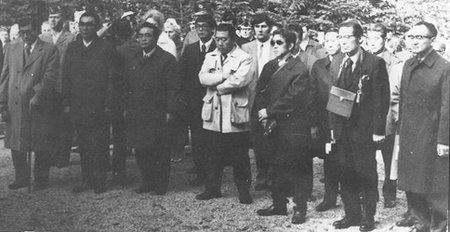
There were two big events that made me feel that I had to voice something. Firstly, in 1971, the first group of veterans of the 442nd RCT came to Bruyeres. In those days, I was one of the few that could speak English and I was probably the only one who knew the history and the emplacement of the big battles in the forest. I was also the vice-president of the Bruyeres-Honolulu sister city Committee since 1969, so I was designated to guide the 17 survivors of K Company to the battlefields. 442 Company K veterans Munaru Saito, Rudy Tokiwa, Joe Shimamura, Richard Oda, Papoose Sadanaga, Fujio Miyamoto, and others with Fred Kusuno, a teacher from Kaiserslautern in Germany, went with me by bus. I received a special permit to be able to reach the site of the lost battalion location as the road was closed by the Forest and Water Organization in those days.
The group stopped in the flower shop where each of them bought one rose. During the trip on the forest crest, I detailed the different battles and the veterans listened to my speech in silence. Then we came to the “Fairy Rock” where the lost battalion was located. Here they all got out of the bus and we all began to spot the different fox-holes still visible at the site. Nothing was there to mark the battle. So they choose to lay their flower under some pine trees. There was evidence of the fighting in the trunks of the trees still covered with bullet holes and shrapnel. All came together and cried silently, cried, cried… These heroes don’t usually show very much emotion, but the feelings were too strong. They had lost so many friends here, those tears changed my life forever.
Secondly, in 1977, a group of veterans came from California lead by Kay Ishibashi and Shim Hiraoka. To celebrate the occasion, a film crew from Hawaii with Nino Martin as director made the movie Aloha Bruyeres. We discovered with surprise the story of the internment camps used for the placement of the Japanese Americans in the USA. This took place in the country of Freedom and Justice for all. What a shame!
In 1984, Kay Shory and Ludi Boken from Belbo Film realized Yankee Samurais. When we arrived at Marker Six, one of the eight survivors of I company who reached the Texas lost battalion, Shig Doi, could not keep his tears at bay and hid himself in the bush. Suddenly, he yelled at me from the bushes: “Pierre, please come here!” I jumped in the bushes and, at the feet of Shig Doi, was a fox hole completely intact with not one leaf inside, it just looked like it was dug yesterday. It was unbelievable! Then Shig Doi, in tears, told me: “So many young boys died here, for what? Nobody will know.” My decision was made up and I told him: “Shig, I swear they will know.”
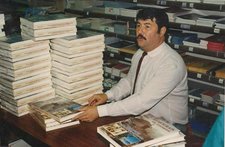
So I gave myself three missions that were nothing compared to the one the 442nd RCT faced during the war, but it took me 25 years to fulfill them:
The first mission was to let the people of France know the story of those Nisei Soldiers. I wrote in 1988 the book U.S. Samurais en Lorraine, in French, published by Gerard Louis editions and noted by The President of the Republic of France Francois Mitterrand.
The second mission was to bring as many inhabitants of Bruyeres (France) as possible to Honolulu (Hawaii) so they could learn first-hand what Bruyeres means to these Veterans. The Battle of Bruyeres is considered as one of the ten most important battles in the history of the United States and because of the Nisei soldiers’ heroism in Bruyeres, they became the most decorated unit in all US History. I brought the first group of 66 Bruyerans to Hawaii in 1976 for a “Fantalohastic” Visit to Paradise opening the way for many more groups coming the following years…
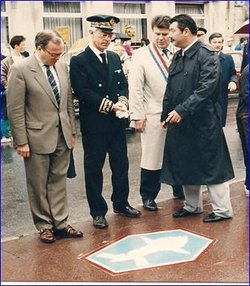
My third mission was to imprint the mark of the Battle onto Bruyeres soil. So I donated the city a Fountain of Peace and Freedom to be visible in the streets of Bruyeres since the two Memorials erected in Bruyeres — in 1947 by my grandfather Deputy Mayor Charles Etienne and Mayor Gillon and the one in Biffontaine in 1984 by Mayor George Henri and Jean Bianchetti — were located in the middle of the forest.
Walking the freedom trail in Boston in 1969, I dreamt for years to be able to do the same for my heroes. The Bicentennial of the French Revolution and the first presentation of the Bill of human rights to the French Convention gave me the opportunity to realize my third goal. I created and realized the Peace and Freedom Trail marked with 89 plaques retracing the story of each location.
In the meantime, I saved the Jewish synagogue from destruction; it eventually became the Museum Henri Mathieu and told the story of the Japanese Americans to the visitors.
Performing those tasks were not that easy. When I started, I was just concerned with keeping the legacy of my heroes alive. When my first son Sebastien was born, I didn’t realize what legacy I would leave behind. It was when I got my second boy Martin, in 1998, that I visualized my work as forever proof of my love for my heroes, the American Samurais of the 100th/442nd RCT, and the grandfather of my sons, Max-Henri Moulin, the silent and quiet hero who was my father.
Link: http://www.discovernikkei.org/en/journal/2011/10/18/legacy-for-my-sons/
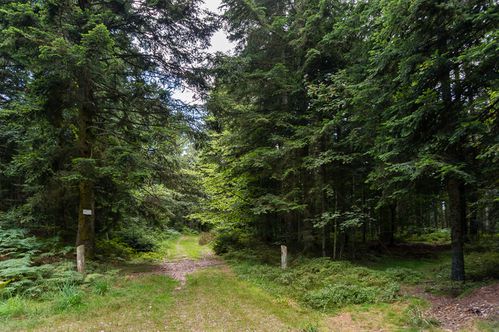


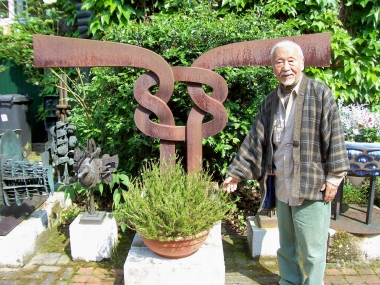
One Coment, RSS